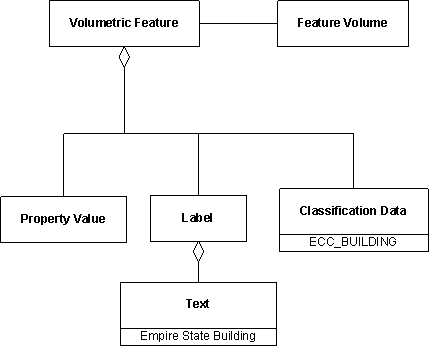The SEDRIS Data Representation Model
APPENDIX A - Classes
Volumetric Feature
|
|---|
Class Name: Volumetric Feature
Subclasses
This DRM class is concrete and has no subclasses.
Definition
An instance of this DRM class is a
<Primitive Feature> that encloses
a bounded region of three-dimensional space, such as a building or a
room within a building.
Primary Page in DRM Diagram:
Secondary Pages in DRM Diagram:
Example
Consider a <Volumetric Feature>
instance representing a building. It has an associated
<Feature Volume> instance, which
defines its extent, shape, and topological relationships;
a <Classification Data> component
that classifies it as an ECC_BUILDING;
<Property Value> components that
describe its characteristics, such as material composition, and a
<Label> instance that identifies it as
"The Empire State Building".

FAQs
-
Is Level 5 feature topology required in order for
<Volumetric Feature>
instances to exist?
No. In order for <Volumetric Feature>
instances to exist, the SRF must be
three-dimensional, and at least one
<Feature Volume> object must exist.
-
Can a <Volumetric Feature>'s
topology consist of multiple
<Feature Volume> instances? If so,
are these <Feature Volume>
instances required to be adjacent or connected to one another?
A <Volumetric Feature> can
consist of multiple <Feature Volume>
instances. There is no requirement that these
<Feature Volume>
instances be adjacent or connected to one another. For example,
a house with a detached garage could be represented as a single
<Volumetric Feature> with two
associated <Feature Volume>
instances (one for the house itself, and one for the garage).
Constraints
Associated to (one-way) (inherited)
Associated by (one-way) (inherited)
Associated with (two-way)
Composed of (two-way) (inherited)
Composed of (two-way metadata) (inherited)
Component of (two-way) (inherited)
Inherited Field Elements
This class has no inherited field elements.
Notes
Associated to Notes
An association between two <Feature Representation> instances
indicates that the environmental object(s) that they
represent have the semantic relationship indicated by
the <Base Association Data> instance on the association
relationship.
An association between a <Geometry Hierarchy> instance and
a <Feature Representation> instance indicates that the
environmental object(s) that they represent have the
semantic relationship indicated by the <Base Association Data>
instance on the association relationship.
An association between a <Property Grid> instance and a
<Feature Representation> instance indicates that the
environmental object(s) represented by the
<Feature Representation> instance and the <Property Grid> instance
(or some specific cell data within that <Property Grid> instance)
have the semantic relationship indicated by the
<Base Association Data> instance on the association relationship.
Each associated <Property Grid> instance will indicate whether the
entire <Property Grid> instance or only some specific cell data
within it is participating in the relationship in question.
Associated from Notes
An association between two <Feature Representation> instances
indicates that the environmental object(s) that they
represent have the semantic relationship indicated by
the <Base Association Data> instance on the association
relationship.
An association between a <Geometry Hierarchy> instance and
a <Feature Representation> instance indicates that the
environmental object(s) that they represent have the
semantic relationship indicated by the <Base Association Data>
instance on the association relationship.
An association between a <Property Grid> instance and a
<Feature Representation> instance indicates that the
environmental object(s) represented by the
<Feature Representation> instance and the <Property Grid> instance
(or some specific cell data within that <Property Grid> instance)
have the semantic relationship indicated by the
<Base Association Data> instance on the association relationship.
Each associated <Property Grid> instance will indicate whether the
entire <Property Grid> instance or only some specific cell data
within it is participating in the relationship in question.
Composed of Notes
These components support *attributes for derived objects*; that
is, they are used only to specify texture mapping information
for geometry that is derived from the <Primitive Feature> by
the consumer. These <Image Mapping Function> components shall use
<Image Anchor> components to specify the mapping.
This is needed because in many cases, a <Primitive Feature> may be
significant only for a particular domain, such as radar.
Prev: Volume Object.
Next: World 3x3.
Up:Index.
|
Last updated: July 16, 2004
|
Copyright © 2004 SEDRIS™
|
|
